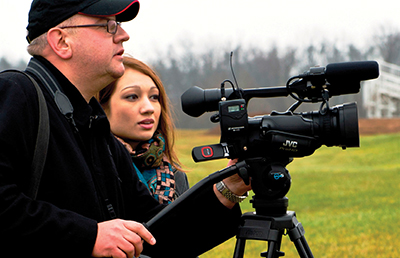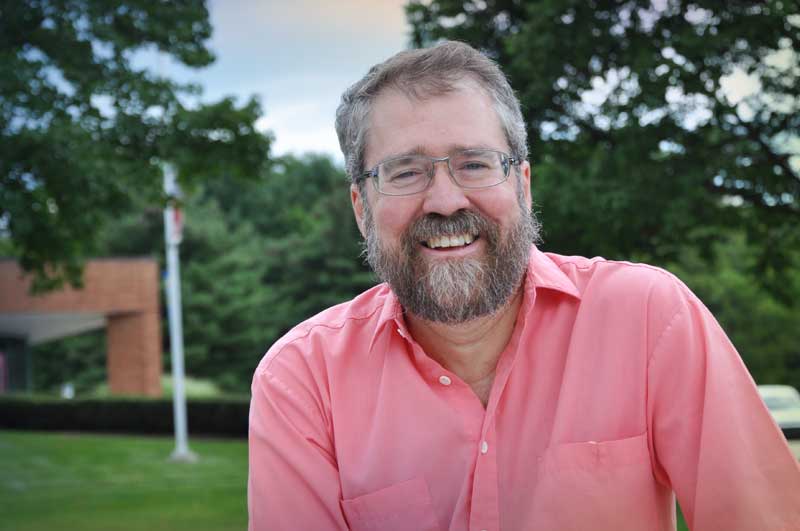JVC’s GY-HM650U ProHD Mobile News Camera

JVC’s new USB-equipped camera is put through its paces on a foggy day.
CENTER VALLEY, PA. -- With competition being fierce among news teams, the first crew to get the story on the air wins the prize. JVC’s introduction of the new GY-HM650U allows field shooters to capture high-definition footage and wirelessly send the video files to an FTP site anywhere on the planet—saving expensive satellite truck time and enabling the crew to move to another location. As developers of the first affordable HD cameras, you would expect nothing less from the innovative JVC—which also happens to be the first to offer this technology.
FEATURES
The JVC GY-HM650U features three 1920 x 1080 1/3-inch CMOS sensors behind an extremely long 23:1 (29 mm to 667 mm) Fujinon F1.6 zoom lens (with an actual iris ring, a three-position neutral density filter, optical image stabilization, and a myriad of zoom functions and speed options). The camera’s 3.5-inch LCD screen is sharp at 920,000 pixels and the 0.44 inch color viewfinder is handy in bright shooting conditions.
The camera captures content on one or two SDXC/SDHC memory cards and features dual codecs, with options for simultaneously recording standard- and high-definition simultaneously, and also providing 480 x 270 for Web delivery. Encoding your footage brings with it several options too, ranging from standard-definition H.264 to high-definition XDCAM EX at 24p, 30p, 50i, and 60i, or AVCHD at 50i or 60i.
Camera outputs abound with a choice of BNC’s for HD/SD SDI, an AV mini-plug, along with HDMI, auxiliary, and headphone jacks. Two-channel XLR inputs and an internal microphone balance out the audio input side of things.
This function-laden camera offers six user presets, menu control options (which are also mirrored on the LCD screen), and a power switch and mode button. The rear of the camera—in addition to accommodating the versatile SSL-JVC50 4900 mAh lithium ion battery—houses the most incredible feature of the unit: the USB host connectivity port.
Once footage has been recorded, thumbnail icons may be selected to be sent to an FTP site, and with a Wi-Fi or broadband dongle attached to the port, files may be uploaded to a remote FTP site using Wi- Fi or 4G connectivity. A status bar will show the progress of your uploaded files. I should add that the Wi-Fi dongle is included with the camera.
IN USE
I was privileged to get my hands on one of the first GY-HM650U cameras available and put it to the test in connection with student field reporting for the campus TV station at our university here in Center Valler, Pa. Not having access to, or the budget for, a microwave or satellite truck, we wanted to see if the camera truly delivered on what it had promised.
On a damp and foggy December afternoon, along with a wind chill of 30 degrees, we recorded footage in the MPEG-2 (60i) mode onto a 16 GB SDHC card. Actually, getting the tripod set up and leveled took more time than preparing the camera for the shoot. With a Hoodman LCD shade on the flip-out LCD screen, we were able to focus the camera on the fogshrouded action. (Not all that many years ago, I would have never attempted a shoot in such unpleasant conditions. However, with JVC’s technology, all the detail was still evident in the picture despite the inclement weather.)
Once we finished shooting several takes of the “action,” it was just a matter of pressing the “source” button to switch the camera to playback mode. We selected three of the best takes and highlighted the thumbnails of each.
With a Verizon 4G LTE adapter plugged into the camera’s port, we selected our FTP site from the list that was displayed on the LCD screen. (Activating the upload displays a progress bar.) On campus, 4G access is sometimes spotty and we usually had to rely on 3G. However, in less than a minute, the footage was on our FTP site for access by our editor.
In this particular situation, we could have driven the mile to our editing location, but we did have several more locations to shoot from ahead of us and sending the footage directly to the edit bay did streamline the process. You can just imagine the possibilities in really fast-breaking news applications.
It’s now a matter of the news crew capturing footage on location, and then in just a very small amount of time, it’s delivered to an FTP site for immediate editing.
That small feat is in itself amazing, and when you add to that the time factor (if your news crew is first on the scene, their story can be wirelessly transmitted for editing and on the air in moments), the cost factor (there’s no longer a requirement for a sat or microwave truck, and no bill for satellite air time), coupled with the “wow” factor, the whole experience really boggles the mind. Now HD footage can be sent wirelessly from just about anywhere.
There really are no negatives associated with this camera. It’s comfortable to use, has all the features you need, and the technology is there to make the most of wireless capabilities. I’m not sure what the next step is going to be—you’ll have to ask JVC.
SUMMARY
If you have a requirement for getting pristine standard- or high-definition footage transported from the camera to another location quickly and inexpensively, this is the only camera that makes it possible so easily and conveniently. Even if you have limited need for remote access to an FTP site, knowing you can do it takes a lot of the pressure off the remote crew. And, you still have excellent footage captured with JVC technology.
Chuck Gloman is an associate professor and chair of the TV/Film department at DeSales University. He may be reachedchuck.gloman@desales.edu.
FAST FACTS
Application
Fast-breaking ENG events
Key Features
Wireless transmission of footage to FTP sites, mall profile and lightweight, solid-state image storage, 23:1 zoom lens, USB port for access to 3G/4G and Wi-Fi networks.
Price
$5,995
Contact
JVC
973-317-5030
www.jvc.com
Get the TV Tech Newsletter
The professional video industry's #1 source for news, trends and product and tech information. Sign up below.
Chuck Gloman is Associate Professor with the TV/Film Department at DeSales University.

